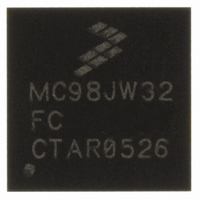MCHC908JW32FC Freescale Semiconductor, MCHC908JW32FC Datasheet - Page 192

MCHC908JW32FC
Manufacturer Part Number
MCHC908JW32FC
Description
IC MCU 32K FLASH 8MHZ 48-QFN
Manufacturer
Freescale Semiconductor
Series
HC08r
Datasheet
1.RD3152MMA7260Q.pdf
(232 pages)
Specifications of MCHC908JW32FC
Core Processor
HC08
Core Size
8-Bit
Speed
8MHz
Connectivity
SPI, USB
Peripherals
LED, LVD, POR, PWM
Number Of I /o
29
Program Memory Size
32KB (32K x 8)
Program Memory Type
FLASH
Ram Size
1K x 8
Voltage - Supply (vcc/vdd)
3.5 V ~ 5.5 V
Oscillator Type
Internal
Operating Temperature
0°C ~ 70°C
Package / Case
48-QFN
Controller Family/series
HC08
No. Of I/o's
29
Ram Memory Size
1KB
Cpu Speed
8MHz
No. Of Timers
1
Embedded Interface Type
SPI, USB
Rohs Compliant
Yes
Processor Series
HC08JW
Core
HC08
Data Bus Width
8 bit
Data Ram Size
1 KB
Interface Type
SPI, USB
Number Of Programmable I/os
29
Number Of Timers
2
Maximum Operating Temperature
+ 70 C
Mounting Style
SMD/SMT
Development Tools By Supplier
FSICEBASE, DEMO908GZ60E, M68EML08GZE, KITUSBSPIDGLEVME, KITUSBSPIEVME, KIT33810EKEVME
Minimum Operating Temperature
0 C
Lead Free Status / RoHS Status
Lead free / RoHS Compliant
Eeprom Size
-
Data Converters
-
Lead Free Status / Rohs Status
Details
- Current page: 192 of 232
- Download datasheet (3Mb)
Keyboard Interrupt Module (KBI)
15.4 Functional Description
Writing to the KBIE7–KBIE0 bits in the keyboard interrupt enable register independently enables or
disables each port A pin as a keyboard interrupt pin. Enabling a keyboard interrupt pin also enables its
internal pullup device. A logic 0 applied to an enabled keyboard interrupt pin latches a keyboard interrupt
request.
A keyboard interrupt is latched when one or more keyboard pins goes low after all were high. The MODEK
bit in the keyboard status and control register controls the triggering mode of the keyboard interrupt.
If the MODEK bit is set, the keyboard interrupt pins are both falling edge- and low level-sensitive, and both
of the following actions must occur to clear a keyboard interrupt request:
192
KBA0
KBA7
TO PULLUP ENABLE
TO PULLUP ENABLE
•
•
•
•
If the keyboard interrupt is edge-sensitive only, a falling edge on a keyboard pin does not latch an
interrupt request if another keyboard pin is already low.
If the keyboard interrupt is falling edge- and low level-sensitive, an interrupt request is present as
long as any keyboard pin is low.
Vector fetch or software clear — A vector fetch generates an interrupt acknowledge signal to clear
the interrupt request. Software may generate the interrupt acknowledge signal by writing a logic 1
to the ACKK bit in the keyboard status and control register (KBSCR). The ACKK bit is useful in
applications that poll the keyboard interrupt pins and require software to clear the keyboard
interrupt request. Writing to the ACKK bit prior to leaving an interrupt service routine also can
prevent spurious interrupts due to noise. Setting ACKK does not affect subsequent transitions on
the keyboard interrupt pins. A falling edge that occurs after writing to the ACKK bit latches another
interrupt request. If the keyboard interrupt mask bit, IMASKK, is clear, the CPU loads the program
counter with the vector address at locations $FFE0 and $FFE1.
Return of all enabled keyboard interrupt pins to logic 1 — As long as any enabled keyboard
interrupt pin is at logic 0, the keyboard interrupt remains set.
KBIE0
KBIE7
To prevent losing an interrupt request on one pin because another pin is
still low, software can disable the latter pin while it is low.
.
.
.
Figure 15-2. Keyboard Module Block Diagram
MC68HC908JW32 Data Sheet, Rev. 6
MODEK
V
REG
D
CK
CLR
NOTE
Q
INTERRUPT FF
KEYBOARD
RESET
ACKK
VECTOR FETCH
INTERNAL BUS
DECODER
IMASKK
SYNCHRONIZER
Freescale Semiconductor
KEYF
Keyboard
Interrupt
Request
Related parts for MCHC908JW32FC
Image
Part Number
Description
Manufacturer
Datasheet
Request
R
Part Number:
Description:
Manufacturer:
Freescale Semiconductor, Inc
Datasheet:
Part Number:
Description:
Manufacturer:
Freescale Semiconductor, Inc
Datasheet:
Part Number:
Description:
Manufacturer:
Freescale Semiconductor, Inc
Datasheet:
Part Number:
Description:
Manufacturer:
Freescale Semiconductor, Inc
Datasheet:
Part Number:
Description:
Manufacturer:
Freescale Semiconductor, Inc
Datasheet:
Part Number:
Description:
Manufacturer:
Freescale Semiconductor, Inc
Datasheet:
Part Number:
Description:
Manufacturer:
Freescale Semiconductor, Inc
Datasheet:
Part Number:
Description:
Manufacturer:
Freescale Semiconductor, Inc
Datasheet:
Part Number:
Description:
Manufacturer:
Freescale Semiconductor, Inc
Datasheet:
Part Number:
Description:
Manufacturer:
Freescale Semiconductor, Inc
Datasheet:
Part Number:
Description:
Manufacturer:
Freescale Semiconductor, Inc
Datasheet:
Part Number:
Description:
Manufacturer:
Freescale Semiconductor, Inc
Datasheet:
Part Number:
Description:
Manufacturer:
Freescale Semiconductor, Inc
Datasheet:
Part Number:
Description:
Manufacturer:
Freescale Semiconductor, Inc
Datasheet:
Part Number:
Description:
Manufacturer:
Freescale Semiconductor, Inc
Datasheet:










